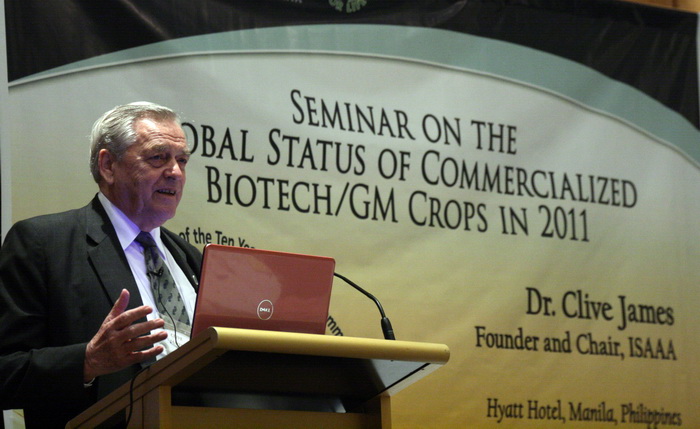
ISAAA Launches 2011 Global Data on Biotech Crops in the Philippines
February 10, 2012| |
A 94-fold increase from 1.7 million hectares in 1996 to 160 million hectares in 2011 makes biotech crops the fatest adopted crop technology in recent history. A record 16.7 million farmers planted biotech crops, over 90% of whom were from developing countries. These data were highlighted in an international webcast on February 7, 2012 by the International Service for the Acquisition of Agri-biotech Applications' (ISAAA) to launch ISAAA Brief No. 43 on the Global Status of Commercialized Biotech/GM Crops in 2011.
The first in a series of country launches in Asia, Africa, and Latin America was held February 8, 2012 at Hyatt Hotel, Manila, Philippines. Dr. Clive James, founder and chair of ISAAA and author of Brief 43, cited the successful experiences of developing countries such as Brazil with biotech crops. The Philippines also remained a top biotech mega-country planting more than 600,000 hectares of biotech crops in 2011. Members of the local scientific community, local government units, non-government organizations, private sector, farmers, regulators, and media practitioners attended the launch and expressed their appreciation of the continuous increase in biotech crops adoption.
Corroborating the significant benefits of biotech crops in the Philippines was the Provincial Agriculture Officer of Isabela Province Mr. Danilo Tumamao, who showed the development of the corn industry in the province since the commercialization of biotech corn in 2003. Mr. Tumamao also said that the province is looking forward to planting other biotech crops particularly those resilient to climate change such as the drought tolerant rice and corn, submergence tolerant rice, and insect-resistant Bt eggplant.
Agriculture Undersecretary for Policy and Planning Segfredo Serrano also shared experiences from a decade of biotech commercialization in the Philippines. Usec. Serrano said that the very interest of the Department of Agriculture on modern biotechnology stems from the very nature of Philippine agriculture which is archipelagic, lacks vast land areas, and the various environment that needs to be dealt with on the development of a technology. He therefore emphasized the need to "exploit the resources of the mind", the output of which is the technology, and the need for the ability of the farming population or the stakeholders to utilize and benefit from the technology.
Dr. Emil Q. Javier, President of the National Academy of Science and Technology (NAST), reiterated in his welcome message the significant developments of biotechnology in the country through government efforts. "So we look forward to making continuing progress to modernize our agriculture by way of applications of modern biotechnology…and finally having Golden Rice served on our tables; we look forward to Bt eggplant similarly getting to our tables, and of course the ringspot papaya virus resistant papaya," he said. On further developing agricultural biotechnology in the country, Dr. Javier said that one firm step is to dedicate a regulatory unit in the Bureau of Plant Industry, with permanent people, adequate laboratory facilities, and all kinds of support.
In his closing message, Dr. Gil Saguiguit, Jr., Director of Southeast Asian Regional Center for Graduate Study and Research in Agriculture (SEARCA), expressed the Center's commitment in supporting technologies and practices that will enhance food productivity and promote sustainable agriculture. He also emphasized the importance of informing and "enlightening the public on the true picture concerning biotechnology".
The seminar was co-organized with ISAAA by the NAST, Biotech for Life Media and Advocacy Resource Center (BMARC) and SEARCA.
To download Highlights of Brief 43 ad other related materials including videos, visit http://www.isaaa.org. For more details about the Philippine launch visit http://www.bic.searca.org.
| |
Biotech Updates is a weekly newsletter of ISAAA, a not-for-profit organization. It is distributed for free to over 22,000 subscribers worldwide to inform them about the key developments in biosciences, especially in biotechnology. Your support will help us in our mission to feed the world with knowledge. You can help by donating as little as $10.
-
See more articles:
-
News from Around the World
- ISAAA Launches 2011 Global Data on Biotech Crops in the Philippines
- WEF Leaders See Need to View Agriculture as a Holistic System
- Germplasm Resources Information Network Launched
- Policy Actions Recommended to Tackle Food Security in Arab World
- Tanzania Has 2 New Cassava Varieties Resistant to CBSD and CMD
- Agriculture Minister Says Tanzania Ready for Biotechnology
- Scripps Research Team Elucidates Structure of UV Protection Molecule in Plants
- ASA Comments on EU Free Trade Agreement
- Japanese Scientists Sheds Light on Genetics of Rice Metabolism
- NCKU's Research on Heat-tolerant Cauliflower Seedlings Benefits World Food Supply
- ICAR Publishes 6th Revised Edition of Handbook of Agriculture
- Regulations on GM Field Trials in Europe: A Review
- European Leaders Say Europe Needs Biotech
- UK Scientists Identify Important Gene in Maize Plant
- EC JRC Publishes New Summary Plant Notifcations
- GM Potatoes Producing Biopolymer as a Renewable Resource
-
Research Highlights
- Scientists Analyze Susceptibility of Mediterranean Corn Borer to Cry1F-expressing Maize
- Functional Characterization of GlZEP Promoter in GE Tomato
- Role of Docs1 in Specification of Outer Cell Layers in Rice Roots
-
Beyond Crop Biotech
- How DNA Finds its Match
- Protein Structures Give Disease Clues
- Gene Therapy Restores Vision in Both Eyes
-
Resources
- EFSA Report on Risk Assessment of Food and Feed Derived from GM Animals
-
Read the latest: - Biotech Updates (December 17, 2025)
- Gene Editing Supplement (December 17, 2025)
- Gene Drive Supplement (February 22, 2023)
-
Subscribe to BU: - Share
- Tweet

